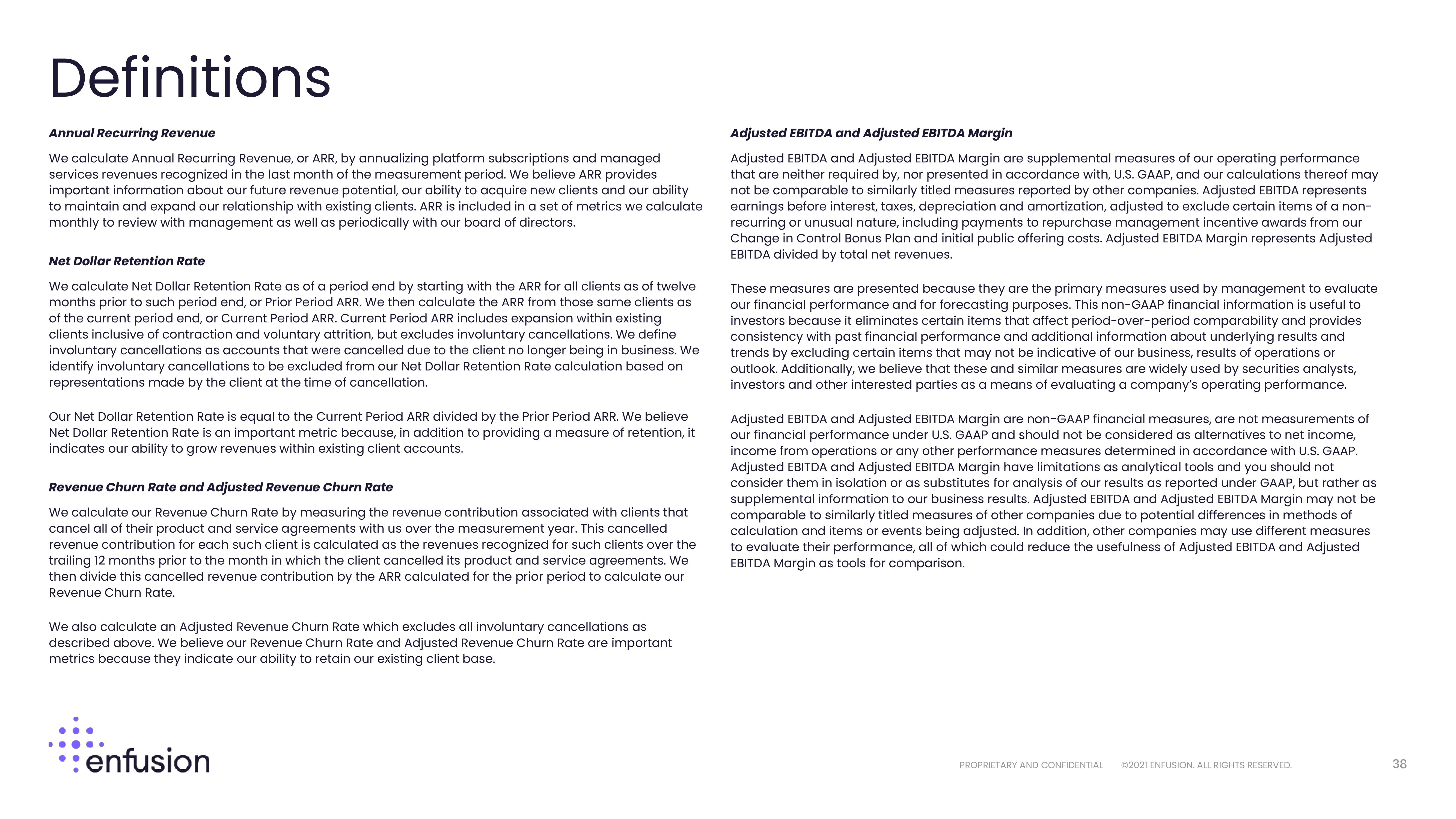Enfusion Investor Presentation Deck
Definitions
Annual Recurring Revenue
We calculate Annual Recurring Revenue, or ARR, by annualizing platform subscriptions and managed
services revenues recognized in the last month of the measurement period. We believe ARR provides
important information about our future revenue potential, our ability to acquire new clients and our ability
to maintain and expand our relationship with existing clients. ARR is included in a set of metrics we calculate
monthly to review with management as well as periodically with our board of directors.
Net Dollar Retention Rate
We calculate Net Dollar Retention Rate as of a period end by starting with the ARR for all clients as of twelve
months prior to such period end, or Prior Period ARR. We then calculate the ARR from those same clients as
of the current period end, or Current Period ARR. Current Period ARR includes expansion within existing
clients inclusive of contraction and voluntary attrition, but excludes involuntary cancellations. We define
involuntary cancellations as accounts that were cancelled due to the client no longer being in business. We
identify involuntary cancellations to be excluded from our Net Dollar Retention Rate calculation based on
representations made by the client at the time of cancellation.
Our Net Dollar Retention Rate is equal to the Current Period ARR divided by the Prior Period ARR. We believe
Net Dollar Retention Rate is an important metric because, in addition to providing a measure of retention, it
indicates our ability to grow revenues within existing client accounts.
Revenue Churn Rate and Adjusted Revenue Churn Rate
We calculate our Revenue Churn Rate by measuring the revenue contribution associated with clients that
cancel all of their product and service agreements with us over the measurement year. This cancelled
revenue contribution for each such client is calculated as the revenues recognized for such clients over the
trailing 12 months prior to the month in which the client cancelled its product and service agreements. We
then divide this cancelled revenue contribution by the ARR calculated for the prior period to calculate our
Revenue Churn Rate.
We also calculate an Adjusted Revenue Churn Rate which excludes all involuntary cancellations as
described above. We believe our Revenue Churn Rate and Adjusted Revenue Churn Rate are important
metrics because they indicate our ability to retain our existing client base.
•*:enfusion
Adjusted EBITDA and Adjusted EBITDA Margin
Adjusted EBITDA and Adjusted EBITDA Margin are supplemental measures of our operating performance
that are neither required by, nor presented in accordance with, U.S. GAAP, and our calculations thereof may
not be comparable to similarly titled measures reported by other companies. Adjusted EBITDA represents
earnings before interest, taxes, depreciation and amortization, adjusted to exclude certain items of a non-
recurring or unusual nature, including payments to repurchase management incentive awards from our
Change in Control Bonus Plan and initial public offering costs. Adjusted EBITDA Margin represents Adjusted
EBITDA divided by total net revenues.
These measures are presented because they are the primary measures used by management to evaluate
our financial performance and for forecasting purposes. This non-GAAP financial information is useful to
investors because it eliminates certain items that affect period-over-period comparability and provides
consistency with past financial performance and additional information about underlying results and
trends by excluding certain items that may not be indicative of our business, results of operations or
outlook. Additionally, we believe that these and similar measures are widely used by securities analysts,
investors and other interested parties as a means of evaluating a company's operating performance.
Adjusted EBITDA and Adjusted EBITDA Margin are non-GAAP financial measures, are not measurements of
our financial performance under U.S. GAAP and should not be considered as alternatives to net income,
income from operations or any other performance measures determined in accordance with U.S. GAAP.
Adjusted EBITDA and Adjusted EBITDA Margin have limitations as analytical tools and you should not
consider them in isolation or as substitutes for analysis of our results as reported under GAAP, but rather as
supplemental information to our business results. Adjusted EBITDA and Adjusted EBITDA Margin may not be
comparable to similarly titled measures of other companies due to potential differences in methods of
calculation and items or events being adjusted. In addition, other companies may use different measures
to evaluate their performance, all of which could reduce the usefulness of Adjusted EBITDA and Adjusted
EBITDA Margin as tools for comparison.
PROPRIETARY AND CONFIDENTIAL Ⓒ2021 ENFUSION. ALL RIGHTS RESERVED.
38View entire presentation